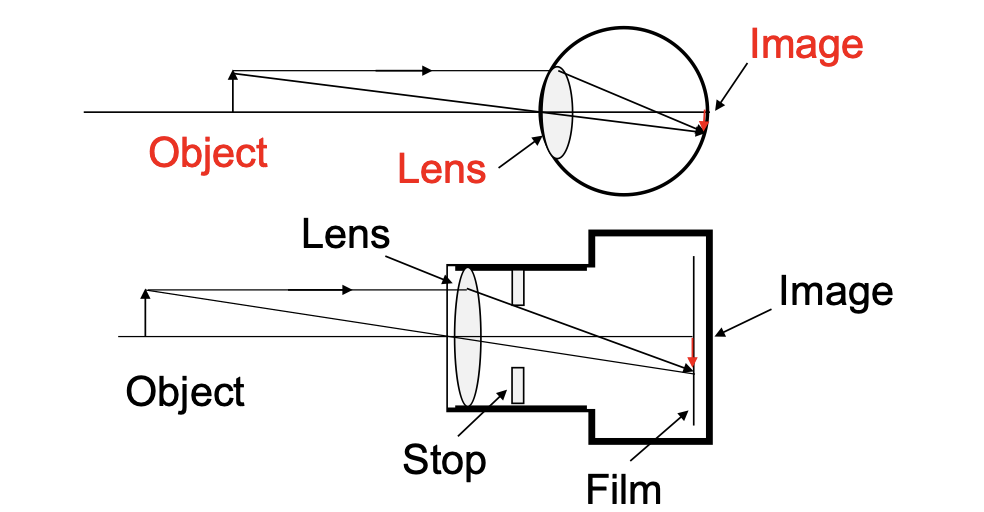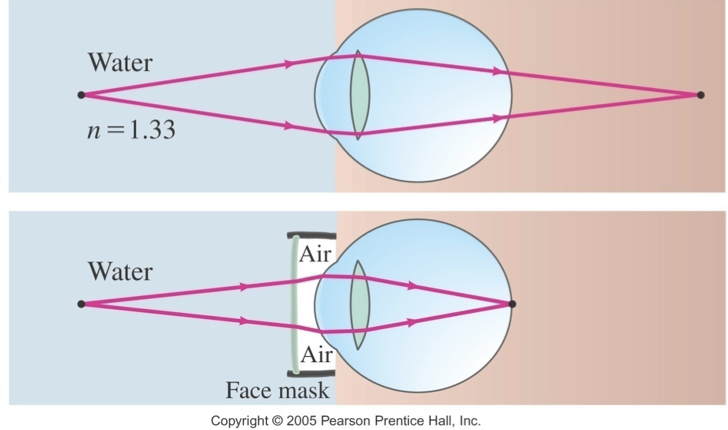Lecture 24: The Human Eye
1/26
Earn XP
Description and Tags
25.2, 25.7, 25.9
Name | Mastery | Learn | Test | Matching | Spaced |
|---|
No study sessions yet.
27 Terms
cornea
does most of the focusing (70%)
R = 8 mm, n = 1.376
Iris
controls light entering the eye
Lens
does fine adjustment to focusing by adjusting its own focal length
n = 1.386 - 1.406
retina - rods and cones
converts light into electrical impulses
optic nerve → brain → image
fovea
most sensitive part of retina
0.25 mm in diameter
consists of closely packed cones
the human eye resembles…
a camera in its basic functioning, with an adjustable lens, the iris and the retina

accomodation by a normal eye
most of the focusing action occurs at the cornea due to refraction
the lens does fine adjustment to focusing by varying its own focal length by changing its thickness by relaxing or contracting ciliary muscles
this focusing adjustment is called accommodation
when we see object at infinity, the eye lens is relaxed and thinner….
hence its f is large
when we see nearby object, the eye lens is thickened…
hence its f is small
what is the range length of the eye lens from far point to the near point for a normal eye, assume diameter of the eyeball = 2cm
1/do + 1/di = 1/f
1/infinity + 1/2 = 1/f
f = 2cm
when object is at near point = 25 cm
1/do + 1/di = 1/f
1/25 + ½ = 1/f
f = 1.85 cm
2-1.85 = 0.15 cm → focal length
near point
closest distance at which eye can focus clearly, for eye it is about 25 cm
far point
farthest distance at which eye can focus clearly, for normal eye it is at infinity
nearsightedness
far point of the eye comes closer to eye. So person can’t see distant objects clearly
farsightedness
near point is too far away from eye. So person can’t see near objects clearly
a nearsighted person has a far point of 52cm, calculate power of lens needed so that person can see distant objects clearly. Assume glasses are worn 2cm in front of the eye
do = infinity
di = -(52-2)=-50
1/do + 1/di = 1/f
f = -50 cm
P = 1/f → 1/-0.5 m = -2 diopter
diverging lens is used to correct nearsightedness

A farsighted person has a near point distance of 45 cm.
Calculate power of the lens needed so that person can read
newspaper held at 25 cm from the eye. Assume glasses are worn
2.0 cm in front of the eye.
do = 25 - 2 = 23
di = -(45-2) = - 43
1/do + 1/di = 1/f
f = 49.45 cm
Power = 1/f = 1/0.495
= +2 diopter
converging lens is used to correct farsightedness
when eyes are opened under water, objects appear blurred, why is this
because light rays are bent much less than they would, if entering the eye from air, hence are not focused on the retina, this can be avoided by wearing goggles
f(in water) > f(in air)

by how much the converging power of the cornea is reduced under water
nc / nw = 1.376/1.333 =1.0323 1.032
therefore, reduced by 3%
what happens when a person uses goggles
nc/n(air) = 1.376/1.000 =1.376 1.376
focusing action is restored to 100%
resolution
the ability of an instrument (eg. camera, telescope, lens) to produce distinct images of two closely spaced point objects
high resolution
closer images, yet distinct
factor that puts limit on resolution
the images formed are not point images, but are blob images use to diffraction effects
effect of diffraction of light
for a circular aperture of diameter D, the central maximum has an angular width theta
theta = 1.22wavelength/D

the Rayleigh criterion states that…
two images are just resolvable when the centre of one peak is over the first minimum of the other
youre in a plane at altitude of 10 000 ,, if you look down at the ground, estimate the minimum separation between objects that you could distinguish. Consider only diffraction effects. Assume diameter of your pupil, D = 3 mm and wavelength of 550 nm
theta = 1.22 wavelength/D
theta = distance/d
distance = theta x d
1.22(550×10^-9)/(3×10^-3) x 10 000
= 2.2 m
the net result is that the eye can resolve objects whose angular separation is about
5 × 10^-4 radian
minimum distance between two objects held at NP (25cm) that normal human eye can resolve? Assuming the angular limit of resolution is 5 × 10^-4 radian
angular limit of resolution
theta = 5 × 10^-4 rad
since theta = distance/L
distance = L x theta
(25 × 10^-2 m)(5 × 10^-4 rad)
x = 0.125 mm